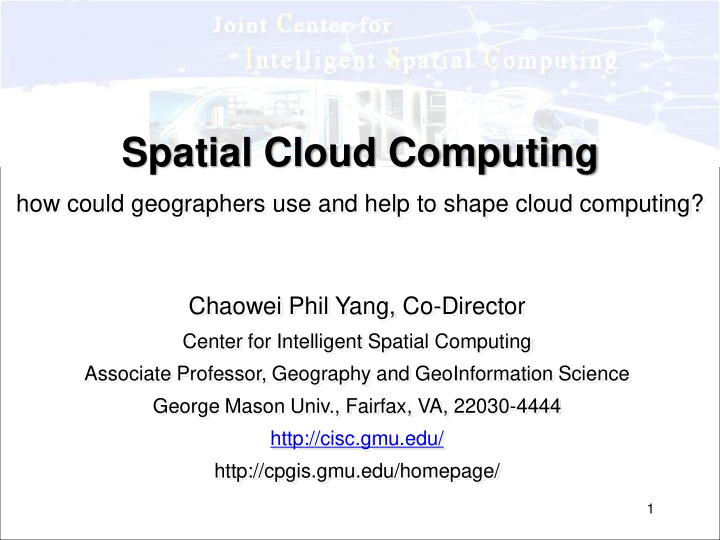



Spatial Cloud Computing how could geographers use and help to shape cloud computing? Chaowei Phil Yang, Co-Director Center for Intelligent Spatial Computing Associate Professor, Geography and GeoInformation Science George Mason Univ., Fairfax, VA, 22030-4444 http://cisc.gmu.edu/ http://cpgis.gmu.edu/homepage/ 1
Cloud Computing Cloud computing is a model for enabling convenient, on- demand network access to a shared pool of configurable computing resources (e.g., networks, servers, storage, applications, and services) that can be rapidly provisioned and released with minimal management effort or service provider interaction. This cloud model promotes availability and is composed of five essential characteristics, three service models , and four deployment models . NIST 2010
Cloud Computing Five essential characteristics: On-demand self-service. provision computing capabilities o as needed automatically. Broad network access. available over the network and o accessed through standard mechanisms. Resource pooling. computing resources are pooled with o location independence Rapid elasticity. Capabilities can be rapidly and o elastically provisioned. Measured Service. automatically control and optimize o resource NIST 2010
Cloud Computing Three service models Cloud Software as a Service (SaaS) o Cloud Platform as a Service (PaaS) o Cloud Infrastructure as a Service (IaaS) o Data as a Service (DaaS) o NIST 2010
U.S. 2010 budget “The Federal technology environment requires a fundamental re-examination of investments in technology infrastructure… Pilot projects will be implemented to offer an opportunity to utilize more fully and broadly departmental and Agency architectures to identify enterprise-wide common services and solutions, with a new emphasis on cloud-computing .”
Spatial Cloud Computing Spatial Cloud Computing refers to the computing paradigm that is driven by geospatial sciences, and optimized by spatiotemporal principles for enabling geospatial and other science discoveries within distributed computing environment. Yang C., Goodchild M., Huang Q., Nebert D., Raskin R., Xu Y., Bambacus M., Fay D., 2011, Spatial Cloud Computing: How geospatial sciences could use and help to shape cloud computing? International Journal on Digital Earth
Workshop 13:00-13:10: Intro to Spatial Cloud Computing (SCC) – Phil 13:10-13:30: Introduction to Azure - Krishna 13:30-14:00: Example with Azure for GEOSS Clearinghouse - Qunying 14:00-14:30: Example with Azure for spatial interpolation – Rezgui 14:30-14:40: break 14:40-15:50: Hands-on with Azure - attendees with help from - Krishna, Qunying, Rezgui 15:50-16:00: Summary and connection to SCC sessions - Phil
Recommend
More recommend